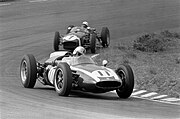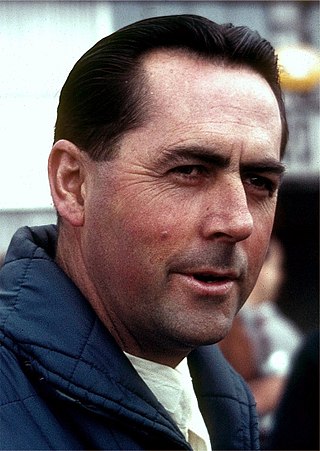
Sir John Arthur "Jack" Brabham was an Australian racing driver and motorsport executive, who competed in Formula One from 1955 to 1970. Brabham won three Formula One World Drivers' Championship titles, which he won in 1959, 1960 and 1966, and won 14 Grands Prix across 16 seasons. He co-founded Brabham in 1960, leading the team to two World Constructors' Championship titles, and remains the only driver to have won the World Drivers' Championship in an eponymous car.

John Norman Surtees was a British racing driver and motorcycle road racer, who competed in Grand Prix motorcycle racing from 1952 to 1960 and in Formula One from 1960 to 1972. Surtees was a seven-time Grand Prix motorcycle World Champion, with four titles in the premier 500cc class with MV Agusta. Surtees won the Formula One World Drivers' Championship in 1964 with Ferrari, and remains the only driver to win World Championships on both two- and four-wheels; he won 38 motorcycle Grands Prix and six Formula One Grands Prix.

The Cooper Car Company was a British car manufacturer founded in December 1947 by Charles Cooper and his son John Cooper. Together with John's boyhood friend, Eric Brandon, they began by building racing cars in Charles's small garage in Surbiton, Surrey, England, in 1946. Through the 1950s and early 1960s they reached motor racing's highest levels as their mid-engined, single-seat cars competed in both Formula One and the Indianapolis 500, and their Mini Cooper dominated rally racing. The Cooper name lives on in the Cooper versions of the Mini production cars that are built in England, but is now owned and marketed by BMW.

Formula Two is a type of open-wheel formula racing category first codified in 1948. It was replaced in 1985 by Formula 3000, but revived by the FIA from 2009–2012 in the form of the FIA Formula Two Championship. The name returned again in 2017 when the former GP2 Series became known as the FIA Formula 2 Championship.

Coventry Climax was a British manufacturer of forklift trucks, fire pumps, racing engines, and other speciality engines.

The 1959 Italian Grand Prix was a Formula One motor race held at Monza on 13 September 1959. It was race 8 of 9 in the 1959 World Championship of Drivers and race 7 of 8 in the 1959 International Cup for Formula One Manufacturers. It was the 29th Italian Grand Prix and the 24th to be held at Monza. The race was held over 72 laps of the five-kilometre circuit for a total race distance of 414 kilometres.
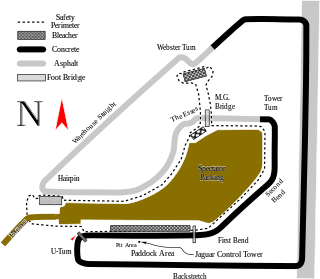
The 1959 United States Grand Prix was a Formula One motor race held on December 12, 1959, at Sebring International Raceway in Sebring, Florida. It was the last of 9 races in the 1959 World Championship of Drivers and the 8th and final in the 1959 International Cup for Formula One Manufacturers.It was the second United States Grand Prix, and the only occasion the race was held at the home of the 12 Hours of Sebring endurance sports car race, the Sebring International Raceway in Florida. The race was held over 42 laps of the 8.36-kilometre circuit for a total race distance of 351 kilometres.
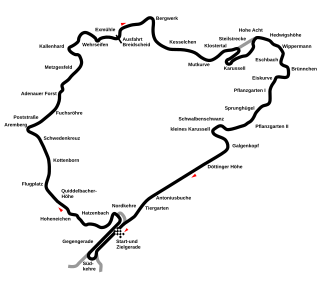
The 1961 German Grand Prix was the 23rd time the German Grand Prix motor race was held. The race also held the honorary designation of the 21st European Grand Prix. It was run to Formula One regulations as race 6 of 8 in both the 1961 World Championship of Drivers and the 1961 International Cup for Formula One Manufacturers It was held on 6 August 1961 over 15 laps of the giant 14.2 mile Nürburgring Nordschleife circuit for a race distance of almost 213 miles. The race also celebrated the 100th race since the establishment of the World Championship in 1950.

The 1966 Formula One season was the 20th season of FIA Formula One motor racing. It featured the 17th World Championship of Drivers, the 9th International Cup for F1 Manufacturers, and four non-championship races open to Formula One cars. The World Championship was contested over nine races between 22 May and 23 October 1966.

The 1961 Formula One season was the 15th season of FIA Formula One motor racing. It featured the 12th World Championship of Drivers, the 4th International Cup for F1 Manufacturers, and numerous non-championship Formula One races. The World Championship was contested over eight races between 14 May and 8 October 1961.

The 1960 Formula One season was the 14th season of FIA Formula One motor racing. It featured the 11th World Championship of Drivers, the third International Cup for F1 Manufacturers and five non-championship Formula One races. The World Championship was contested over ten races between 7 February and 20 November 1960.

Team Lotus was the motorsport sister company of English sports car manufacturer Lotus Cars. The team ran cars in many motorsport categories including Formula One, Formula Two, Formula Ford, Formula Junior, IndyCar, and sports car racing. More than ten years after its last race, Team Lotus remained one of the most successful racing teams of all time, winning seven Formula One Constructors' titles, six Drivers' Championships, and the Indianapolis 500 in the United States between 1962 and 1978. Under the direction of founder and chief designer Colin Chapman, Lotus was responsible for many innovative and experimental developments in critical motorsport, in both technical and commercial arenas.
Four-wheel drive (4WD) has only been tried a handful of times in Formula One. In the World Championship era since 1950, only eight such cars are known to have been built.

The Cooper T51 was a Formula One and Formula Two racing car designed by Owen Maddock and built by the Cooper Car Company for the 1959 Formula One season. The T51 earned a significant place in motor racing history when Jack Brabham drove the car to become the first driver to win the World Championship of Drivers with an engine mounted behind them, in 1959. The T51 was raced in several configurations by various entrants until 1963 and in all no less than 38 drivers were entered to drive T51s in Grand Prix races.
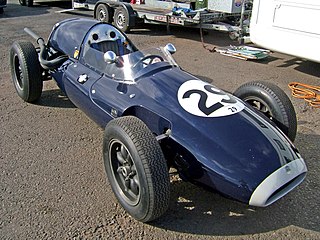
The Cooper T43 was a Formula One and Formula Two racing car designed and built by Cooper Car Company for the 1957 Formula One season, first appearing at the 1957 Monaco Grand Prix in a works car for Jack Brabham. The T43 earned a significant place in motor racing history when Stirling Moss drove a Rob Walker Racing Team T43 to win the 1958 Argentine Grand Prix, the first World Drivers' Championship win for a mid-engined car. Despite this achievement, the car was superseded almost immediately by the T45. The T43's last appearance in a World Championship event was the 1960 Italian Grand Prix.

Owen Richard Maddock was a British engineer and racing car designer, who was chief designer for the Cooper Car Company between 1950 and 1963. During this time Maddock designed a string of successful racing cars, including the Formula One World Championship-winning Cooper T51 and T53 models.

The Zerex Special was a sports racing car. Originally a Cooper T53 built for the 1961 United States Grand Prix, it was rebuilt for usage in American sports car racing, and featured open-top bodywork. Initially using a 2.75-litre version of the Coventry Climax FPF straight-four engine, it later used a Traco-Oldsmobile 3.5-litre V8. The car won numerous races throughout its four-year career, being driven by drivers such as McLaren and Roger Penske.

The Cooper-Climax T55 is a Formula One car built by the Cooper Car Company for the 1961 Formula One season. Its best result was third-place for Bruce McLaren at the 1961 Italian Grand Prix.
Intercontinental Formula was an open wheel, single seater motor-racing formula introduced in 1961 as an alternative to Formula One. As its name implies it was hoped to encourage participation from the United States and Europe, but ultimately the handful of races which ran under the formula all took place in Great Britain, and only for one year.

The Guards Trophy was an Intercontinental Formula motor race held on 7 August 1961 at Brands Hatch Circuit. The race was run over 76 laps of the circuit, and was won by Australian driver Jack Brabham in a Cooper T53-Climax. Brabham lapped the entire field. Jim Clark in a Lotus 18-Climax was second and Graham Hill in a BRM P48 was third. Bruce McLaren in another T53 set fastest lap and finished fourth. Stirling Moss qualified in pole position but retired with gearbox problems.


